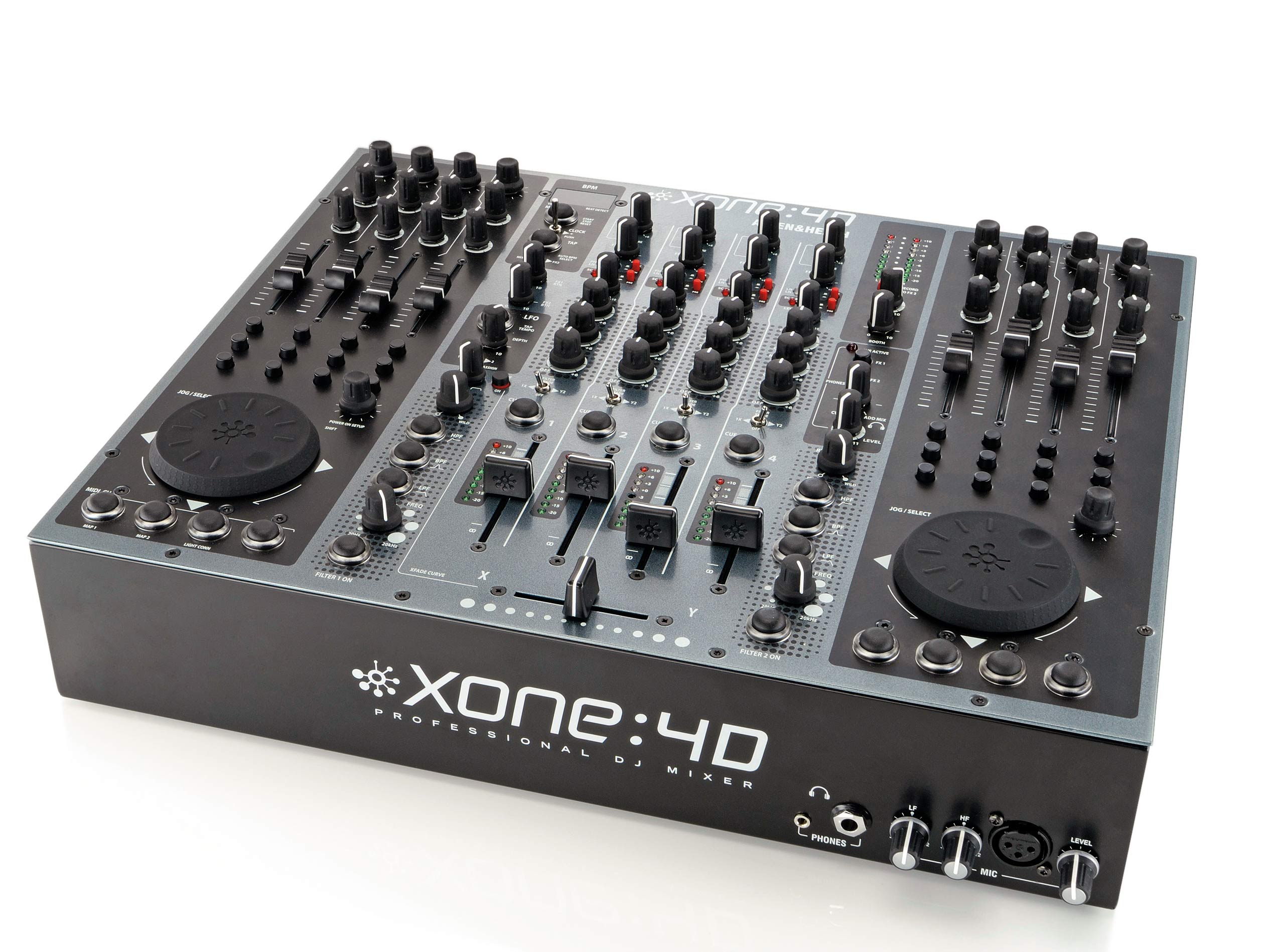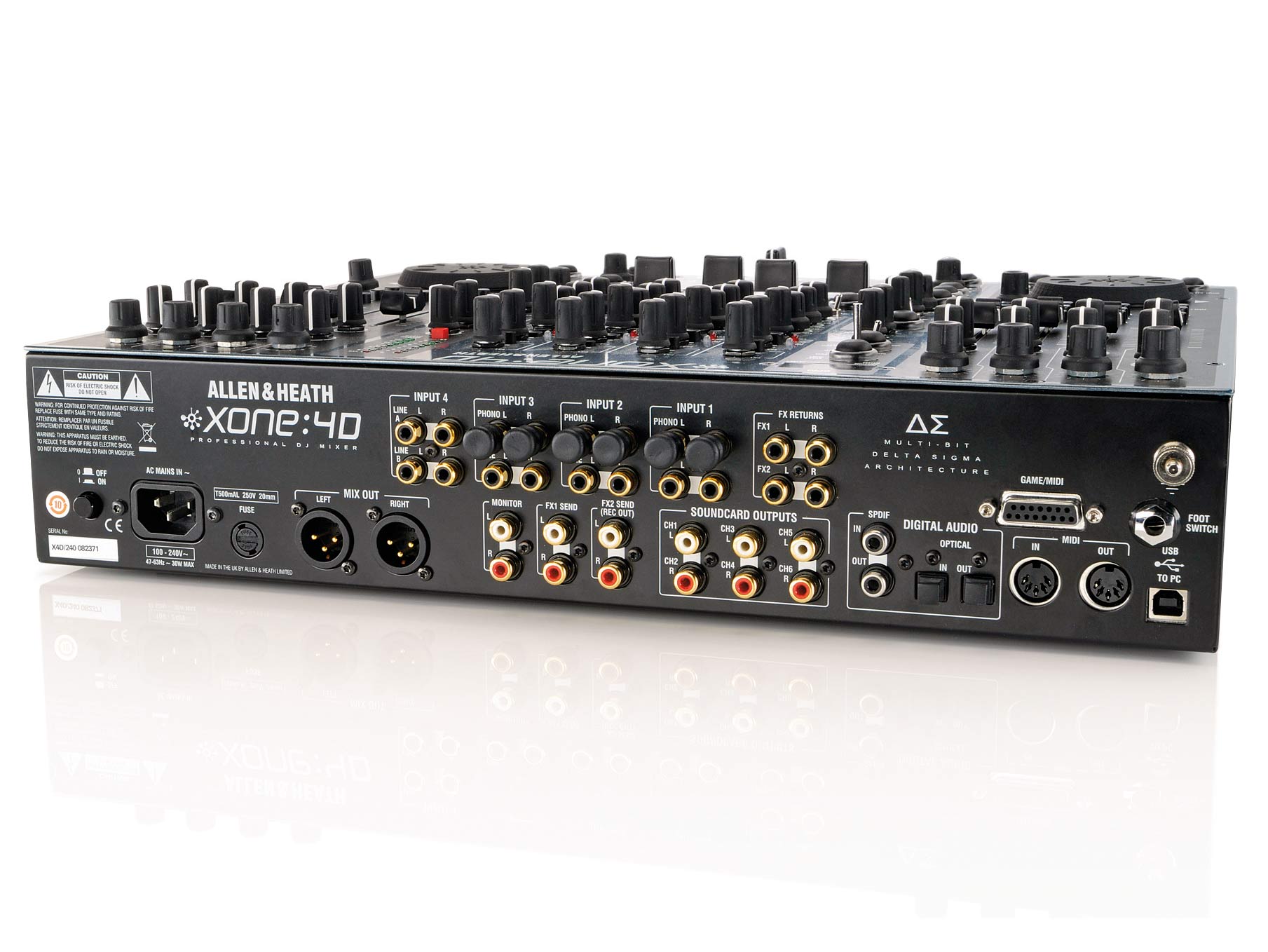MusicRadar Verdict
The ultimate in quality hybrid mixing, and the only real choice for the analogue enthusiast.
Pros
- +
Juicy analogue filters with step sequencer. Lots of flashing lights. Double the MIDI of the 3D.
Cons
- -
MIDI channel/template selection can be tricky.
MusicRadar's got your back

Xone:4D

Xone:4D
Not all DJ mixers are created equal and proof is here in the form of the rather luxurious Xone:4D.
Allen & Heath pioneered the hybrid DJ mixer concept with the Xone:3D. Since then, a horde of well-specified competitors has emerged to compete; so it's time for an update.
The 'hybrid' concept merges together audio, MIDI control and digital audio card technologies; enabling DJs to mix using any combination of decks and software, especially Ableton Live and NI Traktor.
Build
On the surface, the 4D looks like a 3D with the addition of a nice metallic-black paint job. The layout of controls is essentially the same, with a creamy four-channel analogue mixer in the centre flanked by a pair of MIDI control surfaces.
We've already heaped plenty of praise on the stellar qualities of the A&H analogue console, and this mixer continues the tradition in fine form.
There have been some minor changes to the MIDI control section, which aren't initially obvious. First up, there's more space around the dials, which were a bit cramped on the original 3D models.
Connections
Probably the most significant aspect of the upgrade is the all-new connection configurations. It still uses the USB 2.0 connection, but it now boasts a very flexible 10-in/10-out configuration.
These are arranged as stereo pairs, the first four of which are available at the touch of a button on the mixer's line selector, as well as analogue outs on the rear.
This is a big change from the 3D, which required the user to call up the software-based mixer on the computer to make any changes to the configuration.
The recording inputs are fed by the four stereo analogue inputs of the DJ mixer, which offer a choice of either RCA or phono connectors.
Alternatively, you can tap the signal from the FX sends, mic input and master output instead of the line inputs. The final pair (9+10) uses the digital in/out.
This flexible set-up makes it possible for users to bend the Xone:4D to their needs, rather than work around its architecture.
Sound
The sound quality is crisp, clear and rounded out by the analogue circuits of the mixer, with the warm three-band EQ and multi-band filter section adding to the appeal.
The driver performed well on the test MacBook and could easily sustain playback at the minimum of 64 samples, with each audio track routed to its own analogue output on the mixer and all playing simultaneously. Performance-wise, this is about as good as latency values get.
There was no sign of crackle or buffer glitches, just a tight response for audio triggering and premium sonic integrity - impressive!
Filters
In the world of DJ mixers, Allen & Heath is synonymous with juicy analogue filters. In the years since they were first introduced, A&H have tweaked their filters to perfection.
There are two individual VCF's onboard, and these are assignable to the X and Y channels of the cross-fader. Each one has a choice of low-pass, band-pass and high-pass modes, plus rotaries for cut-off and resonance.
This has been kept sensibly well below screaming level; firstly, to keep the music from disappearing altogether into a screaming sine wave, and secondly - to avoid killing clubbers' ears and the resulting lawsuits against DJs that tend to follow suit.
Deploying the VCF is simplicity itself, thanks to the 'one knob per job' design.
The nice use of illuminated buttons gives instant visual feedback in the dark so you always know what the filter is doing, no matter how dingy the venue you're performing at.
The LFO has been upgraded so that alongside the default triangle wave, it has a new step sequence mode for modulating the cutoff.
This mode requires a couple of push button-holding jiggery moves to engage, which can be seen via the three-segment LCD display.
Sequencer
The step sequencer is very much like an old-school eight-step analogue sequencer, and uses the eight sliders to set the levels for each step.
Handily, the sequencer also smoothes out the transition between each step so that it slides between the points, keeping your effects flowing while the tap tempo buttons sets the overall speed of the sequence.
Summary
The Xone's main competitors might have a plethora of built-in effects, but none of them have a real analogue signal path or filters.
The new refinements and multi-channel soundcard make it a more powerful beast than the 3D, especially for live recording/sampling/playback with Ableton or using the internal FX sends of Traktor to spice up a live mix.
Aside from the minor criticisms of the MIDI channel/template selection, The Xone:4D packs a massive amount of function into a luxurious form.
This is a pretty faultless piece of gear that feels like a total tool for next generation DJs who want it all now.
Future Music is the number one magazine for today's producers. Packed with technique and technology we'll help you make great new music. All-access artist interviews, in-depth gear reviews, essential production tutorials and much more. Every marvellous monthly edition features reliable reviews of the latest and greatest hardware and software technology and techniques, unparalleled advice, in-depth interviews, sensational free samples and so much more to improve the experience and outcome of your music-making.
“I called out to Mutt and said, ‘How about this?’... It was a complete fluke": How Def Leppard created a rock anthem - with a little bit of divine intervention
Baby Audio's Smooth Operator spectral balancing plugin goes pro
"It was ugly, like watching a divorce between four people. After a while, I had to get out": Beatles engineer Geoff Emerick on the recording of Abbey Road, track-by-track










